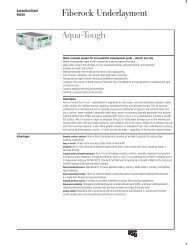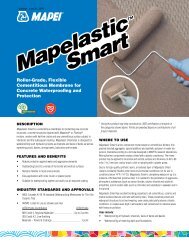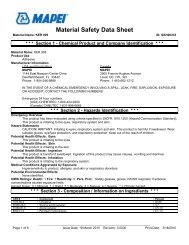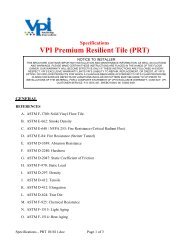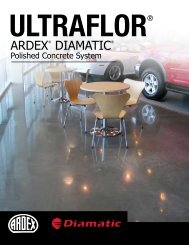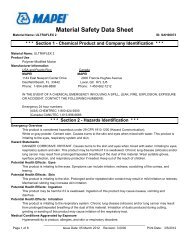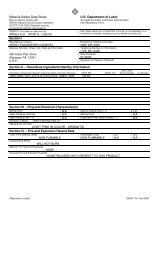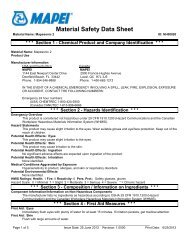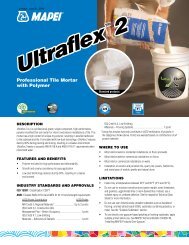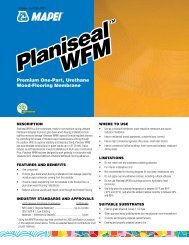Mapelastic 400 Mapelastic 400
Mapelastic 400 Mapelastic 400
Mapelastic 400 Mapelastic 400
Create successful ePaper yourself
Turn your PDF publications into a flip-book with our unique Google optimized e-Paper software.
<strong>Mapelastic</strong> <strong>400</strong><br />
<strong>Mapelastic</strong><br />
LIMITATIONS<br />
• Do not use over in-plane cracks beyond 1/8" (3 mm) or<br />
where vertical out-of-plane movement occurs. (Contact<br />
MAPEI’s Technical Services for recommendations.)<br />
• Do not use over substrates containing asbestos; plywood<br />
in exterior applications; or substrates consisting of plank<br />
wood flooring, presswood, particleboard, chipboard, oriented<br />
strand board (OSB), pressure-treated plywood, oil-treated<br />
plywood, Luaun plywood, Masonite or similar dimensionally<br />
unstable materials.<br />
• Do not apply directly over gypsum-based floor-patching or<br />
leveling compounds, sheet vinyl, existing ceramic, porcelain<br />
or natural stone, vinyl composition tile (VCT), self-stick tile,<br />
laminate surfaces, metal, fiberglass or poured epoxy floors.<br />
• Do not use where excessive substrate moisture and/or where<br />
negative hydrostatic pressure exists. Maximum allowable<br />
moisture is 5 lbs. per 1,000 sq. ft. (2,27 kg per 92,9 m 2 ) per<br />
24 hours per ASTM F1869 or up to 75% relative humidity as<br />
measured per ASTM F2170.<br />
• Do not use: premixed setting materials over <strong>Mapelastic</strong><br />
<strong>400</strong> ; on storage tanks; solvent-based materials such<br />
as sealants and adhesives with <strong>Mapelastic</strong> <strong>400</strong>; or as a<br />
single-application roof-deck membrane, wear surface or<br />
primary waterproofing membrane on balconies or decks over<br />
occupied space.<br />
Consult MAPEI’s Technical Services Department for installation<br />
recommendations regarding substrates and conditions not listed.<br />
SUITABLE SUBSTRATES<br />
Interior and exterior<br />
• Fully cured concrete at least 28 days old (see “Limitations”<br />
section)<br />
• Masonry walls of cement block or brick<br />
• Cured cement mortar beds<br />
• Cement backer units (CBUs)<br />
Interior only<br />
• Gypsum wallboard (walls only, in approved application areas<br />
only)<br />
• Leveling coats<br />
• Properly prepared radiant-heated substrates<br />
• Properly prepared unglazed ceramic tile, cement terrazzo<br />
floors and gypsum underlayments. Note: Existing cement<br />
terrazzo and unglazed ceramic tile must be abraded. Both<br />
must then be skimcoated with an appropriate MAPEI latex<br />
or polymer-modified mortar.<br />
• PVC, copper, brass and stainless steel pipe penetrations<br />
(abraded)<br />
• Exterior-grade plywood (for interior residential floors and<br />
countertops in dry areas only)<br />
Tile Council of North America (TCNA)<br />
Statement on Deflection Criteria<br />
Floor systems, including the framing system and<br />
subfloor panels, over which tile will be installed<br />
should be in conformance with the IRC [International<br />
Residential Code] for residential applications, the<br />
IBC [International Building Code] for commercial<br />
applications, or applicable building codes.<br />
Note: The owner should communicate in writing to the<br />
project design professional and general contractor the<br />
“intended use” of the tile installation, in order to enable<br />
the project design professional and general contractor<br />
to make necessary allowances for the expected live<br />
load, concentrated loads, impact loads, and dead loads<br />
including the weight of the tile and setting bed. The tile<br />
installer shall not be responsible for any floor framing<br />
or subfloor installation not compliant with applicable<br />
building codes, unless the tile installer or tile contractor<br />
designs and installs the floor framing or subfloor.<br />
SURFACE PREPARATION<br />
• Refer to MAPEI’s Surface Preparation Requirements<br />
document for tile and stone installation systems at<br />
www.mapei.com.<br />
• All recommended substrates must be structurally sound,<br />
stable, clean and free of any substance preventing adhesion.<br />
• Do not use chemicals (acid etching or stripping) to prepare<br />
approved substrates.<br />
• Concrete substrates should have a concrete surface profile<br />
(CSP) of #2 per the ICRI (International Concrete Repair<br />
Institute). Mechanically clean and profile by diamondcup<br />
grinding or other engineer-approved method when<br />
necessary.<br />
• Substrate and room temperatures must be between 45°F<br />
and 95°F (7°C and 35°C) during and at least 24 hours after<br />
application.<br />
MIXING<br />
Note: Choose all appropriate safety equipment before use. Refer to<br />
Material Safety Data Sheet (MSDS) for more information.<br />
1. Mix by hand before using.<br />
2. Do not dilute with any other material.<br />
3. Promptly wash tools with water after mixing.



